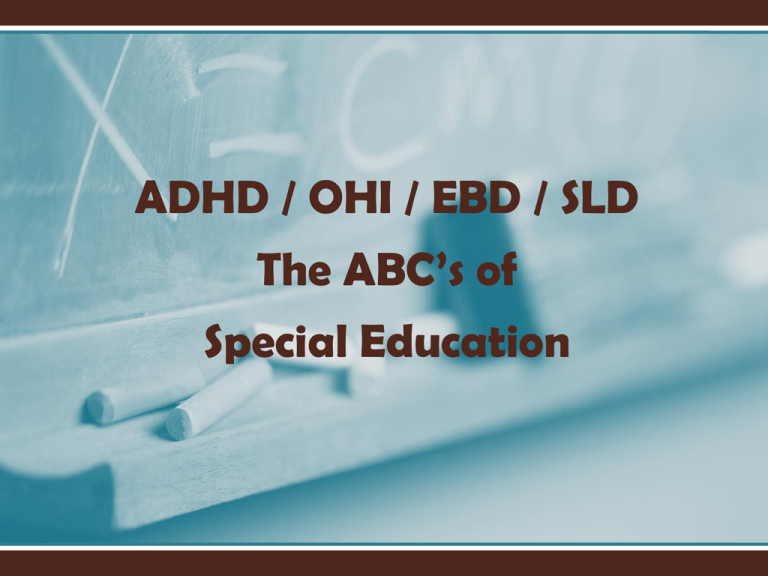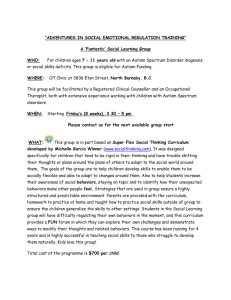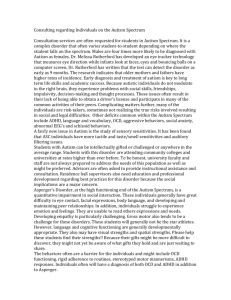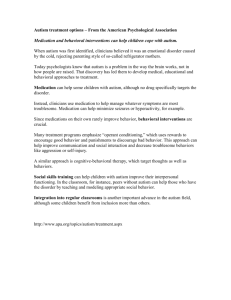ADHD / OHI / EBD / SLD The ABC's of Special Education Other
advertisement

ADHD / OHI / EBD / SLD The ABC’s of Special Education Other Health Impairment • Having limited strength, vitality or alertness including a heightened alertness to environmental stimuli, that results in limited alertness with respect to the educational environment, that: – Is due to chronic or acute health problems such as asthma, attention deficit disorder or attention deficient hyperactivity disorder, diabetes, epilepsy, or heart condition, hemophilia, lead poisoning, leukemia, nephritis, rheumatic fever, and sickle cell anemia; and Tourette Syndrome, and – Adversely affects a student's educational performance. ADHD • Affects up to 5 % of population • One of the most common childhood behavior disorders • Core symptoms include: – Inattention – Hyperactivity – Impulsivity (calling out, leaving seat, interrupting activities) • Students are greatly at-risk for school failure • Medications do not cure ADHD but can help control core symptoms – Does not work for all ADHD – Classroom Interventions and Strategies • Focus on and target specific problem behaviors – Teach appropriate and clearly defined replacement behaviors (what we don't want them to do but what we want them to do). • Conduct a Functional Behavior Assessment to determine factors driving the behavior • Develop a BIP with student input (buy-in) • Utilize positive incentives to reinforce desired behavior Emotional Behavior Disorder An emotional and behavioral disorder is an emotional disability characterized by the following: • An inability to build or maintain satisfactory interpersonal relationships with peers and/or teachers. For preschoolage children, this would include other care providers. • An inability to learn which cannot be adequately explained by intellectual, sensory or health factors. • Consistent or chronic inappropriate type of behavior or feelings under normal conditions. • Displayed pervasive mood of unhappiness or depression. • Displayed tendency to develop physical symptoms, pains or unreasonable fears associated with personal or school problems. EBD • A student with EBD is a student who exhibits one or more of the above emotionally based characteristics of sufficient duration, frequency and intensity that it/they interfere(s) significantly with educational performance to the degree that provision of special educational services is necessary. For preschoolage children, these characteristics may appear within the preschool environment or in another setting documented through an extended assessment period. The student's difficulty is emotionally based and cannot be adequately explained by intellectual, cultural, sensory or general health factors. EBD – Externalizing Behaviors • The most common behavior pattern of children with emotional and behavioral disorders consists of antisocial, or externalizing behaviors. In the classroom, children with externalizing behaviors frequently do the following (adapted from Walker, 1997, p. 13): EBD – Externalizing Behaviors • • • • • • • • • • • • • • • • Get out of their seats Yell, talk out, and curse Disturb peers Hit or fight Ignore the teacher Complain Argue excessively Steal Lie Destroy property Do not comply with directions Have temper tantrums Are excluded from peer-controlled activities Do not respond to teacher corrections Do not complete assignments Continuous conflict around them EBD – Externalizing Behaviors • Antisocial behavior of children with emotional and behavioral disorders often occurs with little or no provocation. • Aggression takes many forms—verbal abuse toward adults and other children, destructiveness and vandalism, and physical attacks on others. • Research indicates that children who display consistent patterns of aggressive, coercive, antisocial, and/or delinquent behavior do not grow out of it. • Anti-social behavior is a strong predictor of delinquency in adolescence. • Children who enter adolescence with a history of aggressive behavior stand a very good chance of dropping out of school, being arrested, abusing drugs and alcohol, having marginalized adult lives, and dying young (Lipsey & Derzon, 1998; Walker et al., 1995). • Students with emotional and behavioral disorders are 13.3 times more likely to be arrested during their school careers than nondisabled students are (Doren, Bullis, & Benz, 1996a), and 58% are arrested within five years of leaving high school (Chesapeake Institute, 1994). EBD – Internalizing Behaviors • • • • • • • • • Do not display aggressive behaviors Little to no social interaction in or outside of school Usually do not play or interact with peers their own age Antisocial and immature behavior creates a serious impediment to their development. Lack social skills needed to make friends and have fun, and they often retreat into daydreams and fantasies. Some are fearful of things without reason, frequently complain of being sick or hurt, and go into deep bouts of depression. Often have anxiety or mood disorders Often not identified due to lack of interaction in the classroom Extreme emotional disorders of some children can lead to self-inflicted injury or even death from substance abuse, starvation, or suicidal behavior EBD – Academic Achievement Impact • Most students with emotional and behavioral disorders perform one or more years below grade level academically (Cullinan, 2002). • Many of these students exhibit significant deficiencies in reading (Coleman & Vaughn, 2000; Maughan, Pickles, Hagell, Rutter, & Yule, 1996) and in math achievement (Greenbaum et al., 1996). • Often have learning disabilities and/or language delays, which compound their difficulties in mastering academic skills and content (Glassberg, Hooper, & Mattison, 1999; Kaiser, Hancock, Cai, Foster, & Hester, 2000). • The disruptive and defiant behavior of students with emotional and behavioral disorders “almost always leads to academic failure which predisposes them to further antisocial conduct” (Hallenbeck & Kauffman, 1995, p. 64). Autism Autism is a developmental disability, generally evident before age three, that adversely affects a student's educational performance and significantly affects developmental rates and sequences, verbal and nonverbal communication and social interaction and participation. Other characteristics often associated with autism are unusual responses to sensory experiences, engagement in repetitive activities and stereotypical movements and resistance to environmental change or change in daily routines. Students with autism vary widely in their abilities and behavior. The term does not apply if a student's educational performance is adversely affected primarily because the student has an emotional and behavioral disorder. [refer to 34 CFR 300.7(c)(1)(i)] Autism The term of autism may also include students who have been diagnosed with Pervasive Developmental Disorder, Asperger's Disorder, Rett's Disorder, or Childhood Disintegrative Disorder provided the student's educational performance is adversely affected and the student meets the eligibility and placement requirements. Autism may exist concurrently with other areas of disability. Autism • A lifelong neurobiological disorder that affects a person’s ability to respond to surroundings, communicate, understand language, play and socially interact with others. • It is also associated with rigid routines and repetitive behaviors. • The first signs usually appear as developmental delays before the age of 3 Autism Characteristics • Difficulty understanding language • Poorly developed social skills and unusual play with toys • Over or under sensitivity to sound, sight, taste, touch, or smell • Repetitive behaviors (rocking, hand flapping) • Certain behaviors exhibited to stimulate the senses (humming) • Difficulty with changes to surroundings or routines • Very high levels of activity for long periods of time • Uneven skill development – some normal, superior, or delayed • Challenging behaviors – aggression, self injury or severe withdrawal • Obsessive/Compulsive Tendencies (handwriting, eating) • Occurs in 1 in 88 children are diagnosed with autism today (compared to 1 in 10,000 in 1993) • 1 percent of the population of children in the U.S. ages 3-17 have an autism • It can occur by itself or with other health problems (mental retardation) Specific Learning Disability • Defined as a disorder in basic psychological processes and secondary underachievement in one or more of the eight areas along with documentation of the lack of response to instructional intervention as supported by ongoing progress monitoring. • Deficits in basic psychological processes typically include problems in attending, discrimination/perception, organization, short term memory, conceptualization/reasoning, executive functioning, processing speed and phonological deficits. SLD – 8 Academic Areas • oral expression • listening comprehension • written expression • basic reading skills • reading comprehension • reading fluency skills • math calculation • math problem solving/reasoning References http://www.education.com/reference/article/children-emotional-behavioral-disorders/ http://nichcy.org/teaching-students-with-e-d http://education.cu-portland.edu/blog/teaching-strategies/5-tips-for-handling-ebd-kids-emotional-behaviordisorder-in-an-inclusive-classroom/ Autism Partnership, Leaf, R., McEachin, J., & Taubman, M. (2005, August). Paper presented at the meeting of the An introduction to Applied Behavior Analysis and Discrete Trial Teaching. Springfield, VA. Autism Speaks, http://www.autismspeaks.org Baker, Jed (2007, May). Conference presented through Future Horizons addressing managing challenging behaviors of children and adolescents with Autism/Asperger Syndrome. Atlanta, Georgia British Columbia Ministry of Education (2000). Teaching Students with Autism: A Resource Guide for Schools. Victoria BC: British Columbia Ministry of Education. Cooner, S. (2005, October). Paper presented at the meeting of the Working with Students with Challenging Behaviors. Fairfax, VA. Dettmer, P., Dyck, N., & Thurston, L. (2005). Consultation, Collaboration, and Teamwork for Students with Special Needs (5th ed.). Boston: Pearson, Allyn, and Bacon. References Fox, L., & Hemmeter, M. (2004). Positive Behavior Support, Training Issues and Strategies. Retrieved October 8, 2005, from http://www.challengingbehaviors.fmhl.udf.edu/presentations/pbstrainingissuechaplhill2004.ppt. Stokes, S. (1999). Structured Teaching: Strategies for Supporting Students with Autism. Retrieved October 26, 2005, from http://www.cesa7.k12.wi.us/sped/autism/structures/str10.htm The Center for Autism and Related Disabilities. (2003, September). CARD Fact Sheet. Retrieved September 22, 2005, from http://www.card.ufl.edu Video Links F.A.T. City training https://www.youtube.com/channel/UCUujNMZnIeWB3VMSUza-mCw/videos Sir Ken Robinson – Ted Talk https://www.youtube.com/watch?v=iG9CE55wbtY







